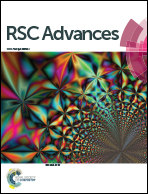Inhibition effects of activated carbon particles on gas hydrate formation at oil–water interfaces†
Abstract
This study presents the inhibition effects of activated carbon particles on the formation of cyclopentane and propane mixed hydrates in the presence of non-hydrate formers and a surfactant. Activated carbon particles gather around the interface between water and oil phases due to their hydrophobicity and this particle layer prevents water molecules from contacting any hydrate guests. The coexistence of cyclopentane and propane mixed hydrates was clearly observed through Raman spectroscopy. The Raman spectra showed that the propane and cyclopentane were enclathrated in the large cages of structure II hydrate. The inhibition efficiency of the activated carbon particles was quantified using high pressure micro differential scanning calorimetry (HP Micro-DSC). The dissociation enthalpies of the mixed hydrates were significantly reduced at 0.5 wt% of activated carbon particles based on the weight of the oil phase. At 1.0 wt% of activated carbon particles, the particle layer completely covered the interface and the seeding hydrate slurry could not penetrate into the water phase and thus hydrate growth was not observed over a 6 hour period. These results show that carbon particles may have good potential as kinetic hydrate inhibitors in offshore gas–oil pipelines.


 Please wait while we load your content...
Please wait while we load your content...